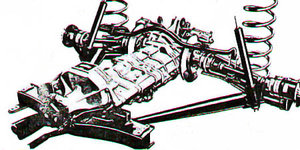Inboard brake
Jump to navigation
Jump to search
An inboard braking system is an automobile technology where the brakes are not located in the wheels, as is common today, but instead near the differential. Moving the brakes inboard reduces unsprung weight substantially, improving ride, handling and braking. This system was more common in the 1960s, found on such cars as the Jaguar E-Type and Citroën 2CV. The Hummer H1 is one of the few modern vehicles fitted with inboard brakes, although this addition was ostensibly to accommodate the Hummer's unusual gear-drive system used at each wheel.
Cars with inboard brakes
- Alfa Romeo: Alfasud
Alfetta
GTV
GTV6
Giulietta
75
90
SZ
Milano - Jaguar E-Type
- Jaguar XJ (until XJ40)
- Jaguar XJ-S
- Rover P6
- Lancia Aurelia
- Citroën 2CV
- Citroën DS
- Citroën SM
- Citroën GS
- Subaru G
- Hummer H1
- Some British Racing Motors racing cars had a single inboard disk brake, acting on both back wheels.
- Lotus Elite Elan Esprit
- Mercedes-Benz W196 and 300SLR
See also
- Car handling
- Center of mass
- Drifting
- Electronic Stability Control
- Fishtailing
- Inboard brake
- Oversteer
- Steering
- Suspension (vehicle)
- Tire
- Understeer
- Unsprung weight
- Vehicle dynamics
- Weight transfer
